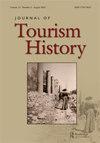Fighting the Cold War on the beach: East–West encounters on the Romanian Black Sea Riviera between the 1960s and the 1980s
IF 0.9
Q4 HOSPITALITY, LEISURE, SPORT & TOURISM
引用次数: 0
Abstract
ABSTRACT This article examines how starting in the 1960s and with the peak in the 1970s and into the early 1980s, the Romanian Black Sea Coast became a hotbed of European tourism with visitors not just from Romania and the neighbouring socialist countries, but also from western capitalist countries. Following the model of more developed tourist countries and lured by the possibility of gaining hard currencies, socialist Romania sought to develop beach tourism so as to attract Western tourists seeking seaside vacations. But, as this article shows, the socialist state was not the only one to benefit from the arrival of Western tourists. The presence of foreign tourists, especially of those from capitalist countries who were in stark majority on the seaside, offered the Romanian citizens the opportunity to mingle and to establish economic and personal relationships that helped them to acquire goods unavailable in ordinary shops, while enabling them to adopt a more cosmopolitan way of life. This article shows that from the mid-1960s until the early 1980s, on the Romanian Black Sea Coast, with the tacit acceptance of local officials, became a space that mingled socialist landscape and values with capitalist material culture.在海滩上打冷战:20世纪60年代至80年代,东西方在罗马尼亚黑海里维埃拉的相遇
本文探讨了罗马尼亚黑海海岸如何从20世纪60年代开始,并在70年代和80年代初达到顶峰,成为欧洲旅游业的温床,游客不仅来自罗马尼亚和邻近的社会主义国家,而且来自西方资本主义国家。社会主义的罗马尼亚遵循更发达的旅游国家的模式,在获得硬通货的可能性的诱惑下,寻求发展海滩旅游业,以吸引寻求海边度假的西方游客。但是,正如本文所示,这个社会主义国家并不是唯一一个从西方游客的到来中受益的国家。外国游客的到来,特别是来自资本主义国家的游客在海边占绝大多数,为罗马尼亚公民提供了交往和建立经济和个人关系的机会,这有助于他们购买普通商店里买不到的商品,同时使他们能够采用一种更国际化的生活方式。本文表明,从20世纪60年代中期到80年代初,罗马尼亚黑海沿岸在当地官员的默许下,成为社会主义景观和价值观与资本主义物质文化相融合的空间。
本文章由计算机程序翻译,如有差异,请以英文原文为准。
求助全文
约1分钟内获得全文
求助全文
来源期刊

Journal of Tourism History
HOSPITALITY, LEISURE, SPORT & TOURISM-
CiteScore
0.60
自引率
0.00%
发文量
16
期刊介绍:
The Journal of Tourism History is the primary venue for peer-reviewed scholarship covering all aspects of the evolution of tourism from earliest times to the postwar world. Articles address all regions of the globe and often adopt interdisciplinary approaches for exploring the past. The Journal of Tourism History is particularly (though not exclusively) interested in promoting the study of areas and subjects underrepresented in current scholarship, work for example examining the history of tourism in Asia and Africa, as well as developments that took place before the nineteenth century. In addition to peer-reviewed articles, Journal of Tourism History also features short articles about particularly useful archival collections, book reviews, review essays, and round table discussions that explore developing areas of tourism scholarship. The Editorial Board hopes that these additions will prompt further exploration of issues such as the vectors along which tourism spread, the evolution of specific types of ‘niche’ tourism, and the intersections of tourism history with the environment, medicine, politics, and more.
 求助内容:
求助内容: 应助结果提醒方式:
应助结果提醒方式:


